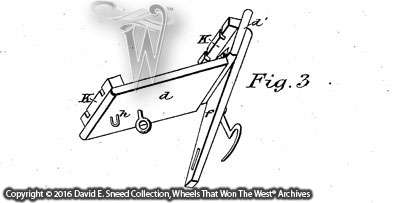Every day old wagons and westernvehicles are overlooked and every day more and more of our nation’s historydisappears. These oversights may seeminsignificant until we realize just how many millions of wheels have completelyvanished or are regularly misrepresented today. After more than two decades of our own search and rescue missions, it’sbecome painfully clear that without a consolidated effort to preserve the best and rarest surviving vehicles in America’s firsttransportation industry, some brands and originality levels will likely be lostforever. Nonetheless, there are successstories that crop up from time to time.
One of the first steps in recovering andpreserving so much of America’s wood-wheeled history is learning what went intoevery part of these vehicles and what the surviving pieces can tell us. To that point, at the front and rear of many farm, freight, ranch, and military wagons were boards typically held in place by rods, pins, clips, chains, or straps. Similar to the tailgate on a modern pickup truck, these “end gates” were engineered to help provide rigidity to the box while also serving otherpractical needs. Hence, a good portionof them were crafted to swing, fold, drop, lift, slide, or remain static. From dumping and loading to creating easier access to contents in the wagon, manyof these innovations were parlayed into patents. Some were readilyaccepted and used by numerous wagon makers. As a result, it’s not uncommon today to run across a wide variety of endgate designs. This week, I thought I’d highlight a few of the ideas popularmore than a century ago.
Folding end gate...
One of the most promoted and readilyaccepted end gate styles was the Comstock patent. Awarded to Charles Comstock in 1870, this wasthe first ‘folding end gate’ design. Theflexible idea was crafted to allow the lower rear end gate of a farm, ranch, mountain, or freight wagon to be taken outwithout going through the time and trouble of removing the box rod. This was especially convenient when the wagonwas lifted up in the front, allowing grain to be dumped. It also assured that the sideboards couldremain somewhat stabilized even though one or more end gates were removed.
 |
| One of the most popular end gates found on antique farm wagons today was originated in 1870 by Charles Comstock. |
Drop end gate...
As a kid and adult, I’ve sat on many trucktailgates. From restful moments on thefarm to social get-togethers at sporting events, the ‘tailgate’ has a longhistory in American vehicles. In myyounger years, most of those pickup truck tailgates were held up by chains withhooks. At the time, I didn’t realizethat the concept had its origins with horse drawn vehicles. In fact, there were a number of patentedvariations of this idea in the 1800's and early 1900's. Shown below are a couple of them.
 |
| This hinged end gate design dates to 1886. Its use of chains to hold the gate level is similar to the way early pickup truck tailgates were configured. |
 |
| The two images shown immediately above feature a 1904 patent. It incorporates hinged, metal straps to hold the end gate. Many modern truck beds still use a comparable design. |
Spring-loaded end gate...
In 1894, the Peter Schuttler WagonCompany unveiled a patent on a spring-loaded rear end gate. The idea was focused on protecting the end gatefrom free-falling on its hinge and slamming against another part of the wagonor some other obstruction. Many earlywagon patents were predicated on a premise of shielding the vehicle fromunnecessary stress or damages. In thiscase, the notion not only helped protect the wagon but, with the resistance ofthe springs, items in the box were prevented from immediately dumping once thegate was freed from the side boards.
 |
| This patented, spring-hung end gate was engineered to protect the wagon while also helping with loose loads such as city coal-hauling operations. |
Okay. There it is; a fundamental look at end gates for wagons. I can only imagine that somebody somewhere iswondering… “Why focus on something as basic as an old wooden end gate?” Actually, I hope someone is asking thatquestion… a lot! After all, only byasking questions do we learn and only by learning can we have any hope oflocating and recognizing some of the last vestiges of America’s early wheeledhistory. So, what ‘secrets’ can an endgate hold? Well, to a certain extent,the designs can help highlight a particular vehicle style, make, purpose, bedwidth, and lower sideboard depth. It’sjust the kind of start to collecting data that helps us hone in on identifying and authenticating thispart of our nation’s past. Without thatknowledge, all we have are best guesses and speculation… just the kind ofdirection that’s allowed so much history to disappear.
Please Note: As with each of our blog writings, all imagery and text is copyrighted with All Rights Reserved. The material may not be broadcast, published, rewritten, or redistributed without prior written permission from David E. Sneed, Wheels That Won The West® Archives.
